By: Camille Pissarro
Week: 1
Camille Pissarro 'Picking Peas' (1887), an oil painting on canvas, is a landscape featuring five female farm laborers in the midst of a pea harvest. They wear head coverings to protect themselves from the sun. The long shadows cast by the women hint that the sun is low in the sky. The setting is outside Pontoise, France, located just over 20 miles from Paris. In the background, a man faces away from the viewer, holding a basket. Pissarro used pointillism to create the field of peas. Pointillism uses small dots of color to create an image.
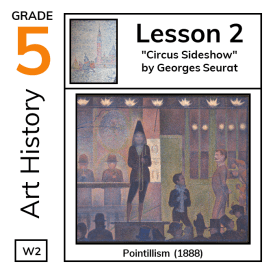
By: Georges Seurat
Week: 2
'Circus Sideshow' (1888), a genre art painting, by Georges Seurat features the Corvi Circus troupe sideshow at the annual Parisian Gingerbread Fair. A trombonist dominates the center platform. To his left, backup musicians play behind a balustrade. To his right, the circus ringmaster holds a riding crop under this arm and a young boy performs. The hatted heads of the audience appear at the bottom of the painting. A row of gas jet flames along the top illuminates the night scene. A barren tree indicates the outdoor location and the winter season. Seurat is well-known for employing pointillism, which uses small dots of color to create an image. Note the dots of blues, yellows, oranges, and greens making up the scene.
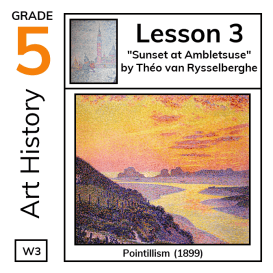
By: Théo van Rysselberghe
Week: 3
Théo van Rysselberghe's 'Sunset at Ambleteuse' (1899), an oil painting on canvas, is a landscape featuring a panoramic view of a glorious sunset. Ambleteuse is a town in the far north of France, where the Slack River flows into the Strait of Dover. At the time Rysselberghe painted the work, Ambleteuse was known as a vacation escape for city people from Paris and Lille. Vacationers swam, fished, and dug for oysters in the bay at Ambleteuse. Rysselberghe used pointillism to create the artwork, employing small dots of color to create the image.
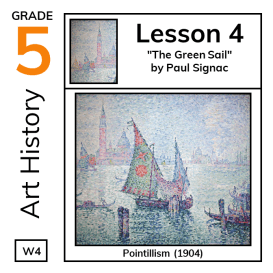
By: Paul Signac
Week: 4
Paul Signac's 'The Green Sail' (1904), an oil painting on canvas, is a cityscape depicting a sailboat gliding over the Venetian lagoon. Nearby in the water, Gondoliers propel their gondolas with long oars. The Venetian skyline, including the dome and tower of the church of San Giorgio (left), provides the backdrop. Signac used pointillism to create the painting. Pointillism uses small dots of color to create an image.
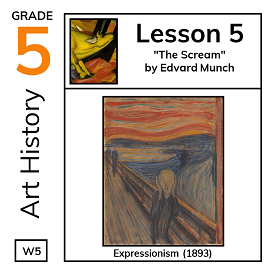
By: Edvard Munch
Week: 5
Expressionist art depicts an artist's subjective emotion or insight rather than objective reality. Norwegian artist Edvard Munch (pronounced Moonk) painted 'The Scream' based on the feelings he experienced while walking under clouds tinted blood red from the sunset. According to [2], he was inspired to create this artwork when he felt an 'infinite scream passing through nature.' Painted in 1893, this artwork preceded the height of the expressionist movement (1905-1920) by over a decade. Correspondingly, Edvard Munch is known as the 'Father of Expressionism.'
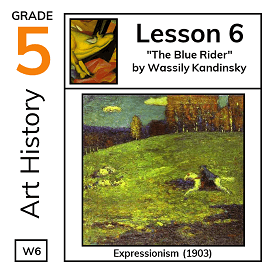
By: Wassily Kandinsky
Week: 6
Russian painter Wassily Kandinsky's 'The Blue Rider' (1903) is notable as it leverages elements of both post-impressionism and expressionism [2]. Recall that visible brushstrokes, thick layers of paint, and real-life subject matter are characteristics of post-impressionist works. Also recall that expressionist art depicts an artist's subjective emotion or insight rather than objective reality. In the painting, a cloaked rider gallops through a sunlit meadow. In the background, forested hills curve under puffy clouds in a bright blue sky. Note how the rider wears the color blue. According to [3], for Kandinsky, blue represents spirituality where the darkness of the blue corresponds to the magnitude of desire for the eternal. Zoom in on the painting to examine the rider - some believe the rider holds a child in their arms.
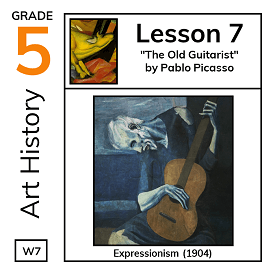
By: Pablo Picasso
Week: 7
Pablo Picasso's 'The Old Guitarist' (1904) shows a portrait of an elderly man playing the guitar on the streets of Barcelona, Spain. This work is part of Picasso's Blue Period, occurring between 1901 to 1904. During this time, Picasso struggled with poverty as well as the death of a friend. The somber blue palette expresses Picasso's sorrow during this period.
By: Franz Marc
Week: 8
German painter Franz Marc's 'Yellow Cow' (1911), an oil painting on canvas, shows a cow joyously frolicking within a vivid landscape. According to [2], color provides the expressionist elements. For Franz Marc, blue symbolizes spirituality/masculinity, yellow stands for passion/femininity, and red represents the earth.
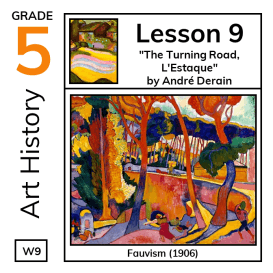
By: André Derain
Week: 9
'The Turning Road, L'Estaque' (1906), an oil painting on canvas, by André Derain is a landscape in the village of L'Estaque in Southern France. Many artists of Derain's time, such as Paul Cézanne, vacationed at L'Estaque, painting the picturesque village and its bay. 'The Turning Road, L'Estaque' derives its name from the turning road which arches across the painting. The swoop of blue near the bottom represents a river being enjoyed by a small cluster of people. One man trudges down the road with a large vase on his shoulder, perhaps gathering water for drinking, cooking, or bathing. In the background, horses trot by on the elevated portion of the road above. The painting exemplifies the avant-garde movement of fauvism with its vivid, unnatural colors and simplified, abstracted imagery. Short-lived, fauvism resulted in only three exhibitions between 1905 and 1908. According to [1], the fauvist style premiered to poor critical review. One particularly scandalized critic named the movement, calling the painters 'fauves' (wild beasts).
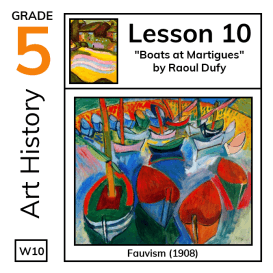
By: Raoul Dufy
Week: 10
'Boats at Martigues' (1908) by Raoul Dufy depicts colorful, abstracted boats bobbing in a marina in the town of Martigues in southern France. Martigues is sometimes called 'The Venice of France' due to its many canals, bridges, and boats [2]. The painting is brightly colored, abstracted/simplified, and painterly, in a true fauvist manner. This painting falls into a new genre, called the marina genre.
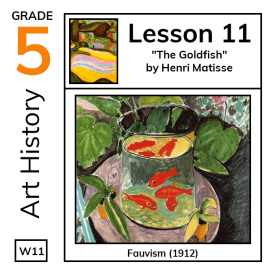
By: Henri Matisse
Week: 11
The French artist Henri Matisse painted the next fauvist painting, 'The Goldfish,' in 1912. Goldfish float in the placid water within in a clear fishbowl sitting atop a table. Potted plants, flowers, and perhaps a wicker chair surround the goldfish. Note the goldfish can be seen from two viewpoints at once - once in greater detail from the side and once again abstracted from the top. Note also how the tabletop seems slanted toward the viewer, as if the fishbowl and potted plants could slide off at any moment. Imagine sitting down and relaxing, inhaling the sweet scent of the flowers and watching the gills, fins, and tails of the goldfish quiver. Like the previous fauvist works, the painting is brightly colored, abstracted/simplified, and painterly.
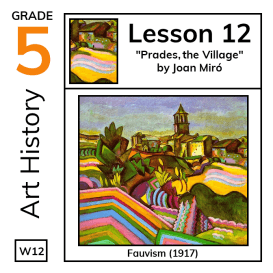
By: Joan Miró
Week: 12
The final example of fauvism is Spanish artist Joan Miró's 1917 painting 'Prades, the Village.' Prades is a small village in far southern France near the border with Spain. The painting depicts a view of Prades and the fields and vegetation outside the village. A tall church tower dominates the village skyline. The fields stand out, painted with stripes, curves, and zigzags in bold, contrasting colors. As with the prior featured fauvist works, the painting is brightly colored, abstracted/simplified, and painterly. The painting creation date falls outside the height of fauvism, somewhat unsurprisingly as it blends in elements of cubism, the next movement to be studied.
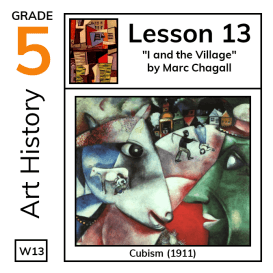
By: Marc Chagall
Week: 13
The next four lessons shift to the cubism art movement, prevalent between 1907-1914. Cubism was an avant-garde artistic movement that depicted of natural forms as geometric structures of planes. The fantastical, dreamlike 'I and the Village' (1911) by Marc Chagall overlays symbols of religion, life, and death. A green man holding a tree and wearing a cross looks at a goat/sheep wearing a similar cross. Layered over the goat/sheep, a milkmaid milks a goat. To the right, a man with a scythe approaches an upside-down woman playing the violin. In the background, a town of houses and a church adorn the skyline. The style is colorful and cubist, with geometric shapes, a fractured appearance, and three-dimensionality.
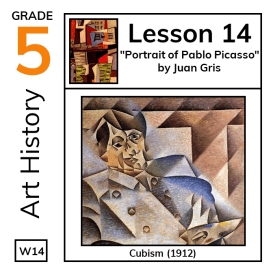
By: Juan Gris
Week: 14
Spanish painter Juan Gris created his cubist 'Portrait of Pablo Picasso' in 1912. Gris featured Pablo Picasso, pioneer of the cubism movement, in this portrait. Recall that cubism was an avant-garde artistic movement characterized by the depiction of natural forms as geometric structures of planes.
By: Fernand Léger
Week: 15
French painter Fernand Léger captured the cacophony of a bustling city his Cubist piece, 'The City' in 1919. Human figures bustle in the midst of a colorful riot of overlapping lines and geometric shapes. Roads, stairs, bridges, buildings, street signs, and scaffoldings of steel beams layer to provide a three-dimensional feel. As with other cubist works, a fractured appearance, three-dimensionality, sharp angles, and the depiction of natural forms as geometric structures characterize the piece.
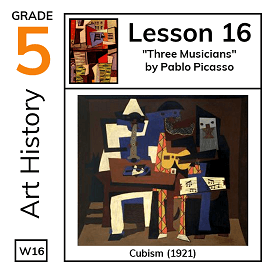
By: Pablo Picasso
Week: 16
The final example of cubism is 'Three Musicians,' created by Spanish painter Pablo Picasso in 1921. Recall that Pablo Picasso is known as the pioneer of cubism. In this work, three musicians sit together and play while wearing flamboyant costumes. According to [2], from left to right, Pierrot, playing a clarinet, wears a blue and white suit, Harlequin, playing a guitar, wears a checkered orange and yellow costume, and a friar, singing and holding sheet music, wears a black robe. A pipe rests on a table before the musicians with a dog lounging below. Also according to [2], Picasso meant this painting to be considered as a still life. Like other cubist works, a fractured appearance, three-dimensionality, sharp angles, and the depiction of natural forms as geometric structures characterizes the piece.
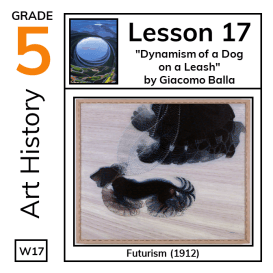
By: Giacomo Balla
Week: 17
The next four lessons focus on the futurism art movement. Originating in Italy, futurism looks forward to consider science and technology, mechanical objects, movement/multiple view points over time, and young people. The influence of other art movements, such as cubism, can be clearly seen in futuristic works. Giacomo Balla's animal genre painting, 'Dynamism of a Dog on a Leash' (1912), captures the movement of a dachshund out for a walk with its owner. The dog's leash, ears, legs, and tail along with the woman's feet are a blur of motion.
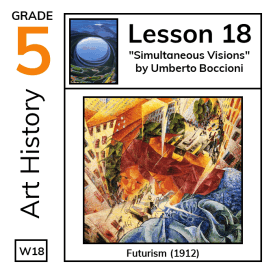
By: Umberto Boccioni
Week: 18
The next example of futurist art is Umberto Boccioni's 1912 oil on canvas cityscape painting, 'Simultaneous Visions.' The artwork portrays a modern city brimming with motion and energy. A woman from two perspectives peers over the busy people below. Overlapping windowed skyscrapers encircle the constant movement in the treed streets below. The artwork demonstrates the movement/multiple view points over time characteristic of futurism.
By: Luigi Russolo
Week: 19
Futurist artist Luigi Russolo paintied the oil on canvas 'Dynamism of a Car' in 1913. The work fractures the image of a moving car into arrows to convey its high speed and direction of motion. Commonly found in futurist works, a focus on movement, technology, and mechanical objects characterizes the piece.
By: Gerardo Dottori
Week: 20
The final example of futurism is an oil on canvas landscape called 'Primavera Umbria' (Umbrian Spring) (1923) by Gerardo Dottori. This painting showcases the Italian Umbria region in the springtime. In this piece, the viewer sees the Umbrian landscape from above. Mountains and rivers stretch out into the distance. Farms and fields in reds and yellows checker the land. Buildings cluster near the lower edge of the painting. Dottori imbued dynamism into this futurist landscape. It appears as if the land swirls around a porthole into the sky.
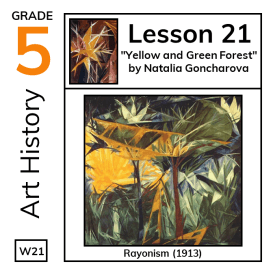
By: Natalia Goncharova
Week: 21
The next four lessons introduce a short-lived but unique art movement called rayonism, occurring circa 1911-1914. Rayonism sought to show objects not precisely as they appear to the eye, but rather the rays of light reflecting off the objects. Russian avant-garde artist Natalia Goncharova painted the featured rayonist work, 'Yellow and Green Forest,' in 1913. As you examine the painting of the yellow and green forest, we see not the actual physical objects, but rather the intangible emanating colored rays of light.
By: Mikhail Larionov
Week: 22
Russian avant-garde artist Mikhail Larionov created the rayonist painting, 'Red Rayonism,' in 1913. This work features intersecting sharp, triangular shards of color in shades of red, yellow, and orange. Interestingly, Larionov and Natalia Goncharova (featured in the prior lesson) were partners in life as well as in creating rayonist art.
By: Natalia Goncharova
Week: 23
Russian avant-garde artist Natalia Goncharova painted the next rayonist work, 'Rayonist Lilies,' in 1913. As you examine the painting, we see not the actual physical lilies, their blossoms, stems, and leaves, but rather the emanating yellow, brown, and green rays of light.
By: Mikhail Larionov
Week: 24
The final example of rayonism is Mikhail Larionov's 1913 painting 'Bull's Head,' showing the white, gray, and yellow rays of light reflecting off the eyes, horns, ears, mouth, etc. of a bull.
By: Wassily Kandinsky
Week: 25
Although versions of abstract art exist going back centuries through today, the 'official' Abstract art movement was prevalent circa 1913-1920s. The next four weeks address abstract art, which breaks with more traditional attempts to accurately represent reality. The first abstract work, an oil painting on canvas by Russian painter Wassily Kandinsky, is titled 'Composition VII' (1913). [2] states "It was thought to be the first purely 'abstract painting' as abstract painting later came to be understood (as a culturally significant form, as opposed to 'mere ornamentation' created as a decorative element)."
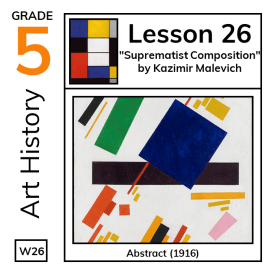
By: Kazimir Malevich
Week: 26
Painted in 1916, Kazimir Malevich's abstract painting 'Suprematist Composition' (also called 'Blue Rectangle Over the Red Beam') features a variety of different overlapping colored shapes on an off-white background. Note how most shapes are oriented diagonally. However, the brown bar just below center stretches horizontally. This painting sold in 2008 for $60 million dollars [2].
By: Wassily Kandinsky
Week: 27
The third example of abstract art, Wassily Kandinsky's 1921 painting 'Blue Segment,' combines multicolored graceful swooping lines and layered shapes.
By: Piet Mondrian
Week: 28
Piet Mondrian's 1923 painting 'Composition A' provides the final example of the abstract art movement. A series of horizontal and vertical parallel lines break up the painting into rectangles of the additive primary colors (red, blue, yellow) plus white, black, and gray.
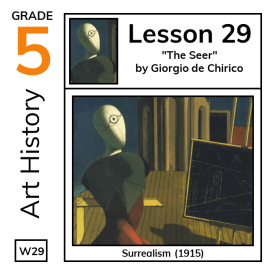
By: Giorgio de Chirico
Week: 29
Surrealism rose to prominence circa 1917-1950. Surrealistic artwork represents the subconscious of the artist - seeking to tap the hidden images or ideas within the minds of the artists. Greek/Italian painter Giorgio de Chirico created the surrealist piece, 'The Seer,' in 1915. In the painting, a mannequin sits on a block of wood at a desk. An architectural drawing on an easel rests next to the mannequin. The mannequin's head twists around, as if looking over its shoulder at the viewer. A mystical star headpiece ornaments the mannequin's head. Wings of black material cover the mannequin's back. A shadow lurks across the floor, formed like a humanoid statue on a pedestal. A brick wall, a dark doorway, and a decorative structure with pillars make up the background.
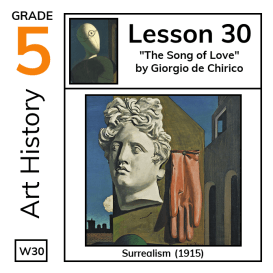
By: Giorgio de Chirico
Week: 30
The next example of surrealism is Giorgio de Chirico's 1915 oil on canvas painting 'The Song of Love.' A green sphere balances before a sculpted Greek head and an enormous surgeon's glove [2]. Arched doorways lead into the building on the right. To the left, a brick wall, a shadowy locomotive, and some smoke create the skyline.
By: Paul Klee
Week: 31
Paul Klee's 1923 surrealist painting 'Puppet Theater,' was likely inspired by the hand puppets and the theater he made for his son, Felix [2]. 'Puppet Theater' features brightly lined props and puppets in the dark framed backdrop of a theater. Recognizable items include a girl puppet in a dress, a curtained window, the sun, a doll, a mushroom, and a dog.

By: Max Ernst
Week: 32
The final example of surrealism is Max Ernst's 1923 painting 'Ubu Imperator' (Translation: Ubu Commander). 'Ubu' originates from a character named Father Ubu featured in plays by French writer Alfred Jarry. Ubu was 'Jarry's metaphor for the modern man; he is an antihero—fat, ugly, vulgar, gluttonous, grandiose, dishonest, stupid, jejune, voracious, greedy, cruel, cowardly and evil [2].' In the painting, an anthropomorphized top with human arms and hands balances on the sand of a barren desert. A green cloth and silvery hair drape over the top's shoulders. One empty eye peers from its leaning tower of a head, along with a small opening for a nose, a mustache, and a volcano-shaped mouth. A scythe defies gravity on the right of the artwork, and additional poles are seen in the distance.
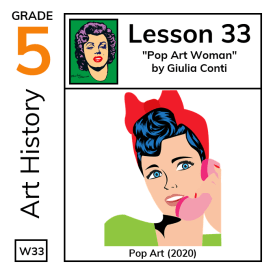
By: Giulia Conti
Week: 33
The final four lessons of this course address the pop art movement. Prevalent between the 1950s to 1960s, pop art represents popular culture, advertising, and comic books using bright colors and cartoony figures and objects. Pop art counters many of the refined, intellectual, and at times pretentious traditional representations of art. The piece featured in this lesson, 'Pop Art Woman' by Giulia Conti, is a cartoon of a woman wearing a 1950's style headscarf and talking on an old-fashioned phone. (Note: As UTH uses mainly materials in the public domain, this precludes use of famous pop art works from the 1950s and 1960s by, for example, Andy Warhol. Instead, modern pieces are presented reminiscent of the movement.)
By: David Bruyland
Week: 34
The next artwork, 'Superman Comics' by David Bruyland, features an array of multicolored Superman comic covers by David Bruyland. The use of comics and bright colors reveal this work as an instance of pop art.
By: Speedy McVroom
Week: 35
The next pop art piece, 'Supermarket Shelf' by Speedy McVroom, features a multicolored cartoon version of a supermarket shelf.
By: Alexander Lesnitsky
Week: 36
The final example of pop art is an homage to Marilyn Monroe by Alexander Lesnitsky. Marilyn Monroe was a famous American actress, model, and singer in the 1950s-1960s famed for her beauty and glamour. The celebrity subject matter, bright contrasting colors, and cartoon representation are all characteristic of pop art.